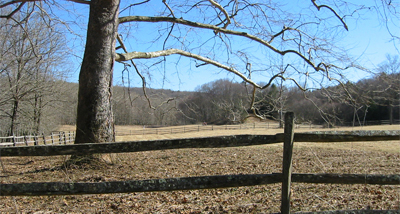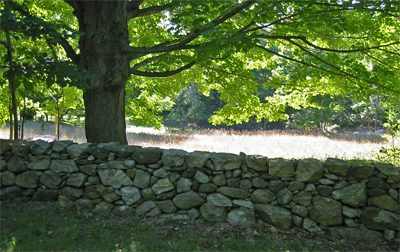Bottom-Up Environmental Planning: CT EarthNet
Traveling around Connecticut one hears similar discussions in towns from Greenwich to Thompson, Stonington to Salisbury. More and more people are expressing concerns about the pace of change in their communities. In churches and synagogues, schools, libraries and meetings of community groups, the talk is about how local surroundings have enriched peoples' lives for centuries--and about how decisions we make today will determine the sort of place Connecticut will be in the future.

This series of posts describes an idea to establish CT Earthnet, a network to support community-based environmental management in Connecticut, to foster real change from the bottom up.
The network would serve to assist community-based groups with fundamental needs, facilitate the sharing of information, learning and experience, build political support and foster collaboration toward the accomplishment of shared objectives. It aims to benefit all groups in Connecticut involved with environmental education, planning and management in ways that government cannot.

I've spent the past three years traveling the state speaking to people about local natural history. Afterwards I have a chance to listen. I've heard what people have to say about what they feel is special about Connecticut. Many recall combing freshly plowed fields for arrowheads, turning over rocks to looke for salamanders and exploring nearby woods and streams as some of their most treasured memories. All wish for the state to remain the kind of place where their grandchildren can grow up having similar experiences.
There is a dissatisfaction with our current direction and a frustration that not enough is being done to protect what we have and change the way we're planning for our communties' and the state's future, and a real recognition that changes need to be made--and quickly.
"Countless residents have come to see their towns at a crossroads. So is the state. Sprawl diminishes open lands that support agriculture, water supplies, wildlife habitat and the character of the Connecticut countryside. It isolates poor and senior citizens, and limits housing variety…" Relentless, helter-skelter development is chewing up CT landscape, The Hartford Courant, editorial, October 10, 2005.
"It’s great to live in Connecticut; we have a quality of life that is the envy of much of America…but that quality of life is threatened…"As we held public hearings in municipalities across the state, we heard from Nutmeggers...We noted that expensive infrastructure is crumbling and going unused in our core cities while being rebuilt at great expense in formerly rural areas. Connecticut is losing open space at a rate twice the national average…"Growth management should come from the bottom up, not the top down…now is the time for a bold agenda for transportation and land use in Connecticut." Groundwork’s Been Laid For Smarter Growth,The Hartford Courant, commentary,July 9, 2006. By Lewis J. Wallace, Jr.Chairman, Planning & Development Committee, Connecticut General Assembly
"A wide variety of recent reports, polls and policy documents agree that Connecticut is at a crossroads...The overriding conclusion is that Connecticut must improve how it manages its public resources if it hopes to…maintain its quality of life. All types of communities—central cities, fully-developed suburbs, newly developing suburbs, and even affluent areas—are hurt by the way Connecticut is growing…Current land use, zoning and tax laws encourage sprawl, traffic, pollution, and poor planning, and contribute to increased segregation of poor people and racial minorities in a few towns and cities." Connecticut’s Future: An Emerging Consensus, CenterEdge ProjectOffice of Urban Affairs, Archdiocese of Hartford.
"The most significant threats to Connecticut’s land and waterscapes include habitat loss, degradation and fragmentation from development; changes in land use; and competition from invasive species. "Other threats include insufficient scientific knowledge regarding wildlife and their habitats (distribution, abundance, and condition); the lack of landscape-level conservation; insufficient resources to maintain or enhance wildlife habitat; and public indifference toward conservation." Connecticut Comprehensive Wildlife Conservation Strategy, November, 2005. State of Connecticut, Department of Environmental Protection.
In light of such local environmental debates, there are questions to be asked about what is the best approach to addressing environmental issues facing Connecticut. Will the answer be in top-down governmental regulation? Is it in bottom up community-based collaborations, or some combination of both? This series of posts aim to inform consideration of such questions.
4 Comments:
Hi:
In Massachusetts there is a "Community Preservation Act" which provides towns with significant money to any of three land uses: Recreational, Historic Preservation, or Affordable Housing.
The way it works is that, if a town votes for it, a small tax surcharge is implemented, along with matching funds from the state. The money is put in an account which rapidly fills up. A town committe decides how to spend the money.
The argument is made that towns spend money on those types of land use anyway, so not having the state's matching funds is a way of losing money.
A number of Towns have implemented the "CPA" and the resulting land preservation is very good. For example Acton implemented the CPA and, as a result, has plenty of money for purchasing and maintaining it's conservation lands. They have some of the best land and trail system around.
I mention this because it might be a usable process for CT, along the lines of what you are asking for.
- Peter W.
Hi Peter,
I live in W Hartfiord and am in 60s. I just keep seeing ways of growing up and ways of connecting with the natural world taken away from young people one after another. I see more literature on the one hand about the sprawl, the heating up. the loss of habitat and or seas, and on the other the 'business as usual' themes from some government and corporations.
So I salute your efforts to address some of this in this blog and through your organization.
Brendan, you might wish to update this post with coverage of your extremely well attended CT Earthnet meeting in New Haven last month. Cheers,
Great stuff --- another good post to read.
Post a Comment
<< Home